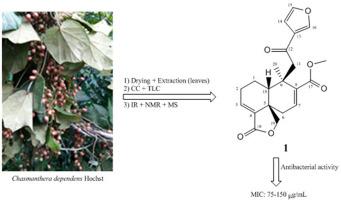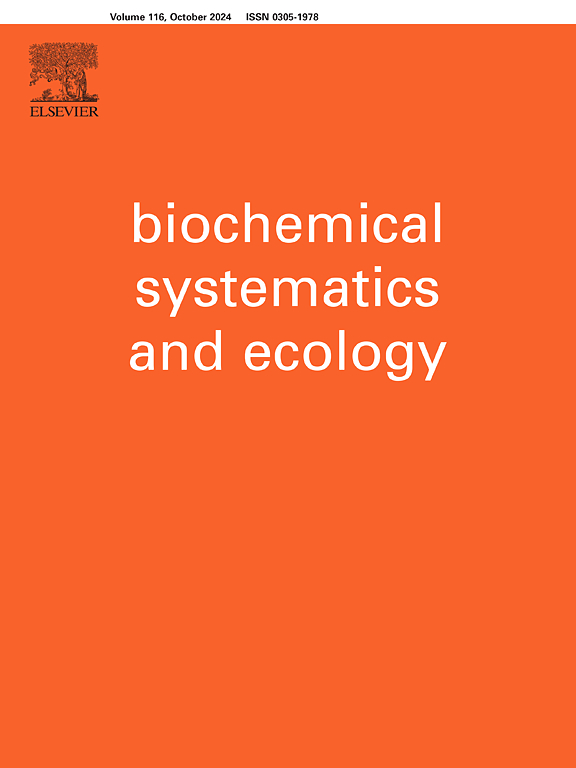来自 Chasmanthera dependens Hochst.(Menispermaceae)中的一种新的抗菌新橙皮烷二萜类化合物和其他成分及其化学分类学意义
IF 1.4
4区 生物学
Q4 BIOCHEMISTRY & MOLECULAR BIOLOGY
引用次数: 0
摘要
通过对 Chasmanthera dependens 的叶、茎和果实甲醇提取物进行化学研究,获得了一种新的新环戊烷二萜(1)以及 17 种已知化合物,包括 3 种二萜(2-4)、6 种三萜(5-10)、4 种甾体(11-14)、1 种倍半萜(15)、1 种木脂素(16)和 2 种酚酸(17 和 18)。通过分析它们的光谱和分光数据,并与文献报道的数据进行比较,确定了它们的结构。除秋水仙素(2)外,其他化合物均为首次从茶树属植物中发现。采用肉汤微稀释法,对提取物、馏分和分离出的化合物进行了体外抗菌试验,分别针对三种革兰氏阳性菌和三种革兰氏阴性菌。叶片的 MeOH 提取物及其馏分 F1-F4 对铜绿假单胞菌具有显著(F4 的 MIC = 93.8 μg/mL)或中等(187.5 ≤ MIC ≤ 375 μg/mL)的活性。Chasmantherenolide (1) 对革兰氏阳性菌株具有中等活性(MIC = 75 μg/mL,202.6 μM)。齐墩果酸(7)对烟曲霉分枝杆菌具有显著的抗菌活性(MIC = 9.4 μg/mL,20.6 μM)。讨论了所分离化合物的化学分类学意义。本文章由计算机程序翻译,如有差异,请以英文原文为准。

A new antibacterial neo-clerodane diterpenoid and other constituents from Chasmanthera dependens Hochst. (Menispermaceae) and their chemotaxonomic significance
The leaves, stems and fruits methanol extracts of Chasmanthera dependens were chemically investigated to afford one new neo-clerodane diterpenoid (1) along with seventeen known compounds including three diterpenoids (2–4), six triterpenoids (5–10), four steroids (11–14), one sesquiterpenoid (15), one lignan (16) and two phenolic acids (17 and 18). Structures were established by analysis of their spectroscopic and spectrometric data and in comparison with those reported from the literature. Except columbin (2), compounds are reported for the first time from the genus Chasmanthera. The extracts, fractions, and isolated compounds were subjected to in vitro antibacterial assays against three Gram-positive and three Gram-negative bacteria, using the broth microdilution method. The MeOH extract of the leaves and its fractions F1–F4 had significant (MIC = 93.8 μg/mL for F4) or moderate (187.5 ≤ MIC ≤ 375 μg/mL) activities against Pseudomonas aeruginosa. Chasmantherenolide (1) was moderately active (MIC = 75 μg/mL, 202.6 μM) against Gram-positive bacterial strains. Significant antibacterial activity (MIC = 9.4 μg/mL, 20.6 μM) was recorded for oleanolic acid (7) against Mycobacterium smegmatis. The chemotaxonomic significance of the isolated compounds was discussed.
求助全文
通过发布文献求助,成功后即可免费获取论文全文。
去求助
来源期刊

Biochemical Systematics and Ecology
生物-进化生物学
CiteScore
3.00
自引率
12.50%
发文量
147
审稿时长
43 days
期刊介绍:
Biochemical Systematics and Ecology is devoted to the publication of original papers and reviews, both submitted and invited, in two subject areas: I) the application of biochemistry to problems relating to systematic biology of organisms (biochemical systematics); II) the role of biochemistry in interactions between organisms or between an organism and its environment (biochemical ecology).
In the Biochemical Systematics subject area, comparative studies of the distribution of (secondary) metabolites within a wider taxon (e.g. genus or family) are welcome. Comparative studies, encompassing multiple accessions of each of the taxa within their distribution are particularly encouraged. Welcome are also studies combining classical chemosystematic studies (such as comparative HPLC-MS or GC-MS investigations) with (macro-) molecular phylogenetic studies. Studies that involve the comparative use of compounds to help differentiate among species such as adulterants or substitutes that illustrate the applied use of chemosystematics are welcome. In contrast, studies solely employing macromolecular phylogenetic techniques (gene sequences, RAPD studies etc.) will be considered out of scope. Discouraged are manuscripts that report known or new compounds from a single source taxon without addressing a systematic hypothesis. Also considered out of scope are studies using outdated and hard to reproduce macromolecular techniques such as RAPDs in combination with standard chemosystematic techniques such as GC-FID and GC-MS.
 求助内容:
求助内容: 应助结果提醒方式:
应助结果提醒方式:


